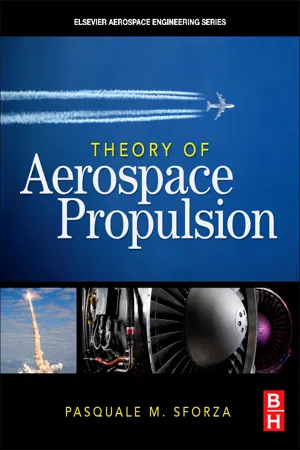
- 704 pages
- English
- ePUB (mobile friendly)
- Available on iOS & Android
Theory of Aerospace Propulsion
About this book
Theory of Aerospace Propulsion provides excellent coverage of aerospace propulsion systems, including propellers, nuclear rockets, and space propulsion. The book's in-depth, quantitative treatment of the components of jet propulsion engines provides the tools for evaluation and component matching for optimal system performance. Worked examples and end of chapter exercises provide practice for analysis, preliminary design, and systems integration.Readers of this book will be able to utilize the fundamental principles of fluid mechanics and thermodynamics to analyze aircraft engines; understand the common gas turbine aircraft propulsion systems and be able to determine the applicability of each; perform system studies of aircraft engine systems for specified flight conditions; perform preliminary aerothermal design of turbomachinery components; conceive, analyze, and optimize competing preliminary designs for conventional and unconventional missions. The book is organized into 15 chapters covering a wide array of topics such as idealized flow machines; quasi-one-dimensional flow equations; idealized cycle analysis of jet engines; combustion chambers for airbreathing engines; nozzles and inlets; turbomachinery; blade element analysis of axial flow turbomachines; turbine engine performance and component integration; propellers; liquid rockets; solid propellant rockets; nuclear rockets; space propulsion; and propulsion aspects of high-speed flight.This book will appeal to aerospace or mechanical engineers working in gas turbines, turbomachinery, aircraft propulsion and rocket propulsion, and to undergraduate and graduate level students in aerospace or mechanical engineering studying aerospace propulsion or turbomachinery.- Early coverage of cycle analysis providesa systemsperspective, and offers context for thechapters on turbomachinery and components- Broader coverage than found in most other books - including coverage of propellers, nuclear rockets, and space propulsion - allows analysis and design ofmore types of propulsion systems- In depth, quantitative treatments of the components of jet propulsion engines provides the tools for evaluation and component matching for optimal system performance- Worked examples and end of chapter exercises providepractice for analysis, preliminary design, and systems integration
Frequently asked questions
- Essential is ideal for learners and professionals who enjoy exploring a wide range of subjects. Access the Essential Library with 800,000+ trusted titles and best-sellers across business, personal growth, and the humanities. Includes unlimited reading time and Standard Read Aloud voice.
- Complete: Perfect for advanced learners and researchers needing full, unrestricted access. Unlock 1.4M+ books across hundreds of subjects, including academic and specialized titles. The Complete Plan also includes advanced features like Premium Read Aloud and Research Assistant.
Please note we cannot support devices running on iOS 13 and Android 7 or earlier. Learn more about using the app.
Information
Outline
1.1. Conservation Equations
 |
| FIGURE 1.1 Schematic diagram of idealized flow machine and associated streamtube control volume. |
Table of contents
- Cover image
- Table of Contents
- Front Matter
- Copyright
- Preface
- Chapter 1. Idealized Flow Machines
- Chapter 2. Quasi-One-Dimensional Flow Equations
- Chapter 3. Idealized Cycle Analysis of Jet Propulsion Engines
- Chapter 4. Combustion Chambers for Air-Breathing Engines
- Chapter 5. Nozzles
- Chapter 6. Inlets
- Chapter 7. Turbomachinery
- Chapter 8. Blade Element Theory for Axial Flow Turbomachines
- Chapter 9. Turbine Engine Performance and Component Integration
- Chapter 10. Propellers
- Chapter 11. Liquid Rockets
- Chapter 12. Solid Propellant Rockets
- Chapter 13. Nuclear Rockets
- Chapter 14. Space Propulsion
- Chapter 15. Propulsion Aspects of High-Speed Flight
- Appendix A. Shock Waves, Expansions, Tables and Charts
- Appendix B. Properties of Hydrocarbon Fuel Combustion
- Appendix C. Earth's Atmosphere
- Appendix D. Boost Phase and Staging of Rockets
- Appendix E. Safety, Reliability, and Risk Assessment
- Appendix F. Aircraft Performance
- Appendix G. Thermodynamic Properties of Selected Species
- Index